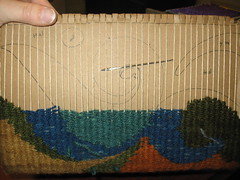The blog is dead. Trust me on this.
 tapestry box project 18 (Photo credit: slowlysheturned)
tapestry box project 18 (Photo credit: slowlysheturned)
I don’t say that lightly; I’ve been blogging since 2000, moving from an email list I started in the 90’s to Blogger to TypePad to WordPress.com to WordPress.org. My blog is now directed off my Stealthmode blog domain to SVBTLE, where it lives at francinesblog.com. I couldn’t decide what to do with it, because I was originating posts in Google+, Facebook, and Evernote more and more often. And I can’t really “blog” on my phone; so when I am at an event, I’m more likely to live tweet, and then convert those tweets later into a Storify.
And then I heard yesterday’s discussion on The Gillmor Gang and spoke to my Business and Future of Journalism class. The Gang got a brief introduction to Betaworks‘ new content authoring tool Tapestry. John Borthwick, who runs Betaworks, explained to us that Tapestry was designed for completely mobile content consumption; it is a clean, uncluttered environment and you download the app to read the content. Or to create it. It creates “Tappable stories.” You have to see it to believe it, just as you had to see SVBTLE or Medium, the new content platform put forward by Ev Williams.
All of these are incredibly different from traditional blogs. They are much less text heavy, and they focus on design. God knows what they will do to journalism when they become main stream — because they will. Many of the people entering the internet now will never even see a PC or a laptop; they will read on mobile devices. So the format of content is rapidly changing.
Medium is still by invitation only, or I’d be using it today. This underscores a discussion being had among journalism professors like Jeff Jarvis and Jay Rosen, who are discussing on Twitter whether the “article” is still a viable form of journalism. If journalism is now a process, continually updating and iterating on the facts in any given event, then you can’t really freeze it in an article anymore. News is a river that happens all day and night, all over the world, which is why Twitter is so compelling. If you read Matthew Haughey‘s piece on why he doesn’t like Facebook and does like Twitter, you will get it all. Twitter was invented for mobile; Facebook is behind on mobile. Facebook is predicated on the past; Twitter is in the now.
So I see that moving my blog around like this is just staving off the inevitable; we are moving to collections and curations, to mobile content, and to different authoring tools. Think for a moment about the incredible popularity of Tumblr, or of Pinterest. I believe they are early iterations of the content revolution.
I told my journalism students, who are just being taught by their professors that the new way is “digital first,” that they have to stretch again — this time all the way to “mobile first.” What does this mean if you wanted to be a feature writer, an investigative reporter, a business writer, or a TV producer?
Nothing. You can still BE any of those things. You just have to avoid being wedded to old platforms.
That’s why I know blogging is dead. It won’t die all at once, but just you wait…




{ 2 comments… read them below or add one }
I don’t think the blog is dying, it’s just evolving. Instead of an “article” in the old journalism sense, it’s going to be an amalgam of pieces: words, pictures, music, video…
The best skills a J student can learn is how to get the story. That’s never going to die. How it translates (to a page, a stream, whatever) will be a whole other thing though.
PS. also remember the whole aspect of chat/virtual worlds, which are going to be incorporated into our destinations in the future
Getting and telling the story will never die — you’re right about that. How you tell it does change and evolve.